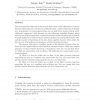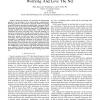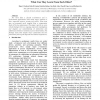5302 search results - page 1 / 1061 » Learning How to Separate |
ALT
2001
Springer
14 years 2 months ago
2001
Springer
The main question addressed in the present work is how to find effectively a recursive function separating two sets drawn arbitrarily from a given collection of disjoint sets. I...
CSE
2009
IEEE
13 years 12 months ago
2009
IEEE
—When the Internet was conceived, its fundamental operation was envisioned to be point-to-point communication allowing anybody to talk directly to anybody. With its increasing su...
HICSS
2009
IEEE
13 years 12 months ago
2009
IEEE
For more than a decade e-Commerce and eGovernment applications have made major impacts in their respective sectors, private and public. Some time ago, we presented early insights ...
CORR
2008
Springer
13 years 5 months ago
2008
Springer
Maximum Variance Unfolding (MVU) and its variants have been very successful in embedding data-manifolds in lower dimensionality spaces, often revealing the true intrinsic dimensio...
EUROCOLT
1999
Springer
13 years 9 months ago
1999
Springer
Abstract. Recent works have shown the advantage of using Active Learning methods, such as the Query by Committee (QBC) algorithm, to various learning problems. This class of Algori...



